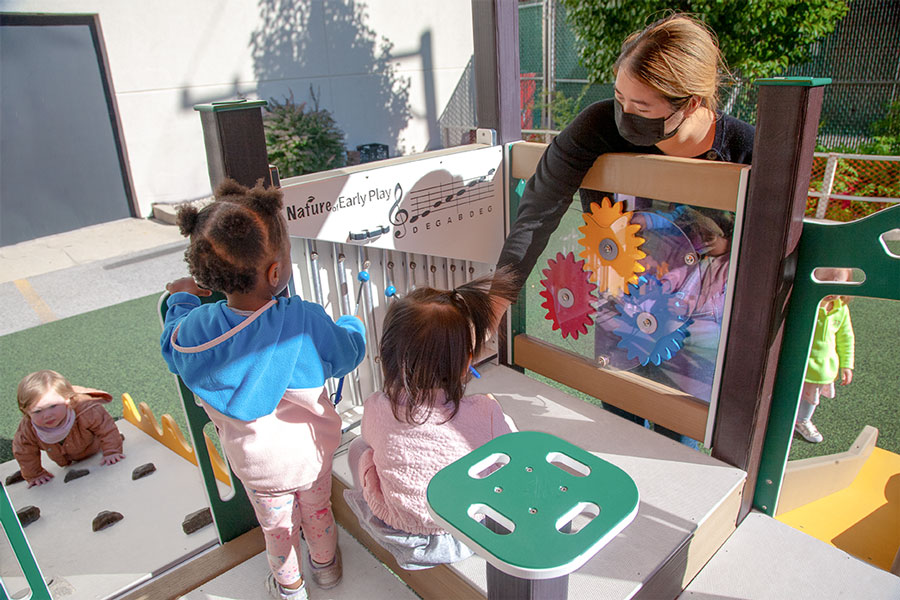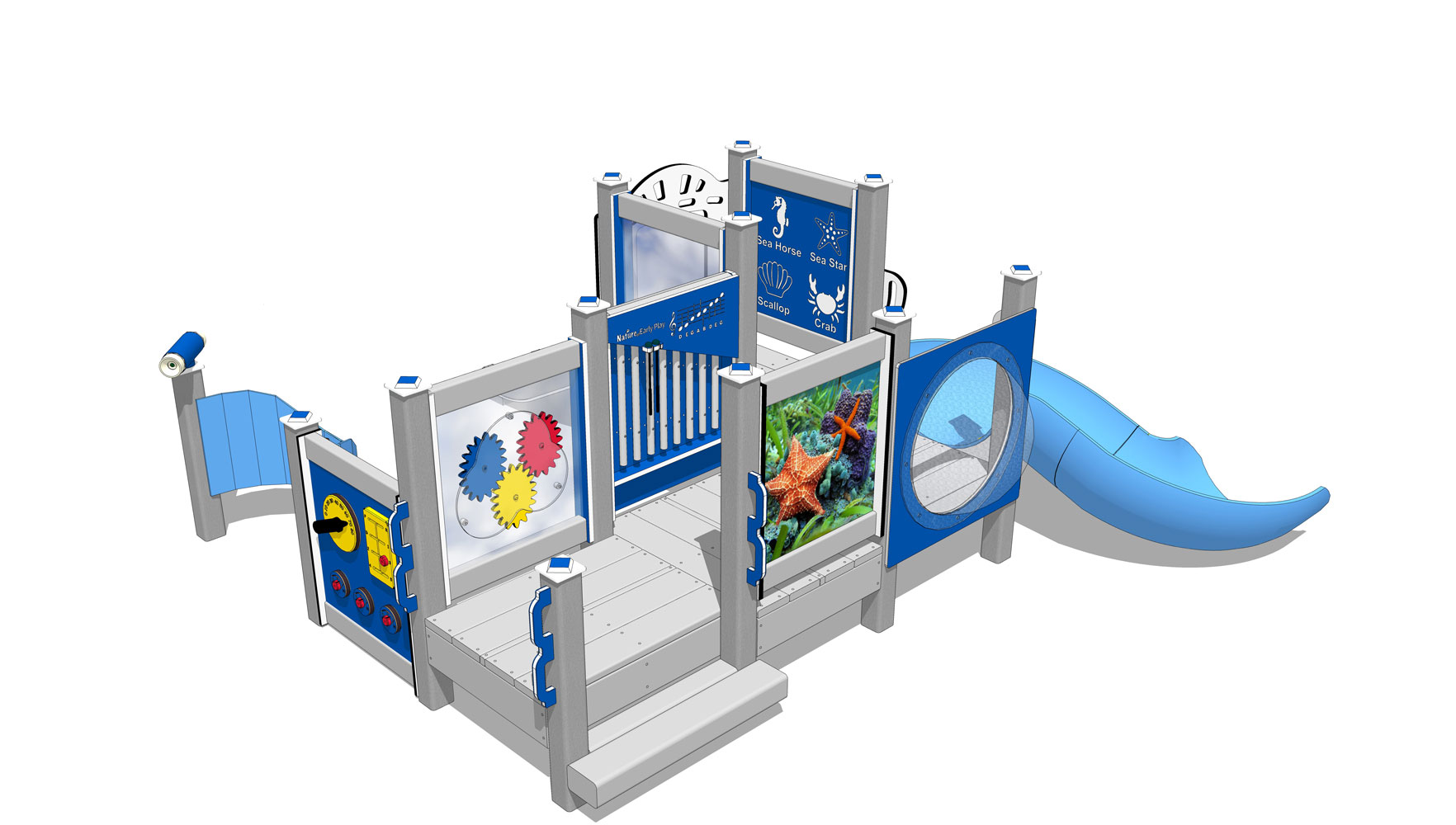More than Just Mini: How Infant and Toddler Playground Equipment is Designed for Child Development
 A colorful playground naturally attracts children of all ages, but you may not realize that most playground equipment isn’t suitable for younger kids. Babies and small children go through different stages of physical development, requiring age-appropriate play equipment. Our Nature of Early Play by Play Mart products prioritize the safety and growth of your little ones while they explore, learn, and have fun.
A colorful playground naturally attracts children of all ages, but you may not realize that most playground equipment isn’t suitable for younger kids. Babies and small children go through different stages of physical development, requiring age-appropriate play equipment. Our Nature of Early Play by Play Mart products prioritize the safety and growth of your little ones while they explore, learn, and have fun.
Our playgrounds are designed to cater to the varying ages and stages of development, ensuring a safe yet exciting environment for children. We believe that providing activities that suit their sizes and capabilities can promote growth and stimulate exploration. Moreover, our inclusive approach also offers opportunities for children with disabilities to experience the joys of play.
Our expertise in early childhood development has allowed us to create products tailored specifically for the 6 to 23-month age group. In fact, our journey began with a realization that there were limited options for age-appropriate playground equipment nationwide. This made Play Mart one of the first playground companies to develop groundbreaking playground equipment for infant and toddler play by introducing our Nature of Early Play line of products.
We understand all age groups’ unique mental and physical abilities and have designed fully age-appropriate products. With Nature of Early Play by Play Mart, child caregivers can confidently provide supervised outdoor time in a challenging yet secure environment for infants and toddlers. Read on to learn more about how toddler and infant playground equipment brings enormous benefits to the tiniest tots!
Why Is Selecting Age-Appropriate Equipment Important?
While you’re perusing the market for outdoor play equipment for your daycare, park, or community center, you may not be looking specifically for infant and toddler playsets. Here’s why you should:
- Safety: Avoid accidents by selecting equipment that matches children’s abilities. Older kids on toddler equipment or younger kids on advanced equipment can lead to accidents and injuries.
- Brain Development: Create an environment that builds children’s cognitive skills with age-appropriate equipment. Equipment made for older children may not stimulate imaginative play or problem-solving abilities that younger ones need.
- Physical Activity: Foster active play by providing equipment that matches their physical skill level. Playgrounds that don’t cater to their interests may result in boredom, which leads to a lack of movement. Promote healthy activity and the development of gross motor skills by providing age-specific physical challenges.
- Social Skills: Foster teamwork and social dynamics by offering equipment that supports group activities and role-playing games. Lack of age-appropriate options can hinder opportunities for cooperative play, which is so important in early childhood.
Consider Age-Specific Developmental Needs
Create a playground targeted to the specific age group to ensure maximum enjoyment for all kids. It’s crucial to match the equipment with the size and development level of the children. As kids grow rapidly from 6 months to 12 years, the playground equipment should also evolve accordingly. If it’s possible at your facility, you may want to consider separating play areas for different age ranges. Here are some specific age-related stages of development that we consider when creating Nature of Early Play preschool equipment.
Ages 6 months – 23 months
It’s easy to see that infants grow rapidly, both physically and mentally. That’s why our primary goal is to support the holistic development of the youngest adventurers in the 6 to 23-month age group.
A baby’s exploration of the world is just beginning! As a baby’s language, thinking, and physical skills continue to grow, they are ready to take on new challenges and learn even more. This means more opportunities for play, making connections, and learning.
Put the fun on repeat!
 Anyone who has been around babies knows how much they love hearing the same song or playing the same game over and over again. (A couple of rounds of “The Wheels on the Bus Go Round and Round.” anyone?) While repetition may not be exciting for parents and caregivers, babies at this age thrive on it! Repetition helps them learn new skills and understand cause and effect. By repeating activities, babies learn that their actions lead to specific responses. For instance, a baby on the Cubs and Kittens can repeatedly drop an object down the sand ramp panel and watch what happens. Infant playground equipment offers opportunities for repetition in a way that’s amusing for them and minimally annoying for their caregivers!
Anyone who has been around babies knows how much they love hearing the same song or playing the same game over and over again. (A couple of rounds of “The Wheels on the Bus Go Round and Round.” anyone?) While repetition may not be exciting for parents and caregivers, babies at this age thrive on it! Repetition helps them learn new skills and understand cause and effect. By repeating activities, babies learn that their actions lead to specific responses. For instance, a baby on the Cubs and Kittens can repeatedly drop an object down the sand ramp panel and watch what happens. Infant playground equipment offers opportunities for repetition in a way that’s amusing for them and minimally annoying for their caregivers!
 Get a grasp on the fun!
Get a grasp on the fun!
The “pincer” grasp is a crucial skill for picking up small objects. It’s a sign of the development of fine motor skills in their fingers. Equipment that is created for infants 6-23 months contains moving components that provide opportunities for little ones to focus their fingers and practice controlling fine movements. We designed the Sensory Cube with spinning discs specifically to hone fine motor skills.
Create some babbling explorers!
 Play and exploration go hand in hand. By playing with toys like a ring stack or shape-sorter, babies learn about object relationships, problem-solving, and trial and error. As babies develop new physical skills like rolling, crawling, and pulling up, their world expands. They become more active and curious, exploring new ways of moving and playing. The Noah’s Ark, adorned with animal graphics, is great for sparking a love of exploration!
Play and exploration go hand in hand. By playing with toys like a ring stack or shape-sorter, babies learn about object relationships, problem-solving, and trial and error. As babies develop new physical skills like rolling, crawling, and pulling up, their world expands. They become more active and curious, exploring new ways of moving and playing. The Noah’s Ark, adorned with animal graphics, is great for sparking a love of exploration!
Ages: 2-5 years
 If you work with preschool children, you know how much development occurs during these years. As kids grow, they go through stages of play. Nature of Early Play preschool playground equipment is specifically designed to foster each type of play:
If you work with preschool children, you know how much development occurs during these years. As kids grow, they go through stages of play. Nature of Early Play preschool playground equipment is specifically designed to foster each type of play:
Onlooker Play:
Around the age of 2, children engage in onlooker play, where they observe others play without active participation. This type of play helps build confidence and social skills, preparing children for future interactions. Incorporate onlooker play by allowing your toddlers to observe each other doing interesting tasks on the playground. The Angelfish incorporates a window panel just for this purpose!
Parallel Play:
 Parallel play is common among children aged 2 to 3 when they play alongside each other but do not directly interact. It signifies their readiness to connect with others and develop social skills. Let children play near each other without forcing interaction. The Sea Critters is perfectly suited for parallel play. One toddler can spin the gear panel while listening to a friend play a tune on the chime panel next to them!
Parallel play is common among children aged 2 to 3 when they play alongside each other but do not directly interact. It signifies their readiness to connect with others and develop social skills. Let children play near each other without forcing interaction. The Sea Critters is perfectly suited for parallel play. One toddler can spin the gear panel while listening to a friend play a tune on the chime panel next to them!
Associative Play:
Around ages 3 to 4, children become more interested in the actions of their peers. They engage with each other while playing but still maintain independence. This type of play aids in social skills, cooperation, language development, and problem-solving.
Cooperative Play:
 Cooperative play occurs around 4 or 5 years old when children actively play together. It allows them to practice and build upon skills learned in previous play stages, such as communication, teamwork, sharing, kindness, empathy, compromise, and problem-solving. Encourage cooperative play by providing opportunities for children to work together towards a common goal. On the Galaxy Express, for instance, little ones can take on roles and work together to keep the train in “motion”!
Cooperative play occurs around 4 or 5 years old when children actively play together. It allows them to practice and build upon skills learned in previous play stages, such as communication, teamwork, sharing, kindness, empathy, compromise, and problem-solving. Encourage cooperative play by providing opportunities for children to work together towards a common goal. On the Galaxy Express, for instance, little ones can take on roles and work together to keep the train in “motion”!
Guidelines for Age-appropriate Playground Equipment
According to the Consumer Product Safety Commission, there are specific equipment recommendations to ensure safe play for each age range:
Toddlers – under age 2
- Climbing equipment under 32 inches high
- Ramps
- Single file step ladders
- Slides
- Spiral slides less than 360°
- Spring rockers
- Stairways
- Swings with full bucket seats
Slides in an infant playground should not exceed an average 24-degree incline, with a maximum slope of 30 degrees, and the bottom of the slide should be no more than 6 inches above safety surfacing.
Our engineers at Play Mart created “Cloud” flooring for our Nature of Early Play products—the perfect surface for your little one’s safety and comfort. With a rubberized texture that is gentle on infant feet and knees, this flooring also helps prevent slips. Plus, it flexes under pressure for a more friendly feel, making any falls less traumatic.
Preschool – ages 2-5
- Size-appropriate climbers
- For children 4-5 years, horizontal ladders no more than 60 inches high
- Ramps
- Rung ladders
- Single file step ladders
- Slides
- Spiral slides up to 360°
- Spring rockers
- Stairways
- Swings – belt, full bucket seats (2-4 year olds), and rotating tire
At a preschool playground, the average incline of a slide should not exceed 30 degrees, with no part of the slide exceeding 50 degrees. The bottom of the slide should be between 7 and 14 inches above safety surfacing if the slide is more than 4 feet high. If the slide is shorter than 4 feet, the bottom of the slide should be less than 11 inches above the protective surfacing. Infant and toddler playgrounds should not include arch climbers, flexible climbers, monkey bars, parallel bars, and other upper-body equipment.
Solutions for a Community Age-Appropriate Playground
If you operate a rec center, park, church, or other community playground, you may have multiple age groups using your equipment. How can you accommodate children of all ages and make sure they’re safe and stimulated? Nature of Early Play by Play Mart has the answer!
Multiple Play Structures
 If possible, create a playground that caters to every age group by incorporating multiple play structures. This ensures that each age range has its own designated play area, reducing the risk of younger children getting knocked down by older kids.
If possible, create a playground that caters to every age group by incorporating multiple play structures. This ensures that each age range has its own designated play area, reducing the risk of younger children getting knocked down by older kids.
To enhance the play value, include independent play items between the different play structures, like our activity panels. These items also help define the separate play spaces.
To further enhance the playground experience, connect each age-specific area with a buffer area such as a seating area or other amenities. Some examples include picnic tables, walking paths, decorative fencing, water fountains, landscaping, and benches.
Remember to ensure that the play areas are always visible from the buffer areas so caregivers can easily keep an eye on children.
Single Play Area
If your facility doesn’t have the space or budget for multiple play structures, Play Mart can help you create an age-inclusive playground that fits any space or budget. Designing a play area that appeals to kids of all ages doesn’t have to be difficult. Consider factors like size and ability level when choosing components. Strike a balance between equipment for younger and older kids.
Here are the key elements for an age-inclusive play area:
- A large upper deck accessible by climbing or ramp.
- Lower decks with shorter fall heights.
- Variety of slides for different ages.
- Visibility for adult supervision.
- Secluded areas for rest.
- Range of equipment to accommodate different abilities.
Give kids the freedom to play however they want while staying within their abilities. Even with limited resources, you can have a playground suitable for all ages. Play Mart also has a line of playsets perfect for kids aged 2-12. Include independent play components for younger kids and challenging ones like monkey bars for older ones. A playground can be safe and fun for everyone!
Have Big Fun With Your Little Ones and Nature of Early Play!
We know you want the best for the infants and toddlers in your care every moment of the day, and that includes playtime! Don’t settle for generic equipment that may not be safe or stimulating for young ones. If you want to build a new infant and toddler play area or replace an old structure, contact our childhood experts at Nature of Early Play. We’ll help you create a unique play area that your babies and tots won’t want to leave!
Share this:
This website and its content are copyright of Play Mart, Inc. All rights reserved. Any redistribution or reproduction of part or all of the contents in any form is prohibited without prior written permission.

